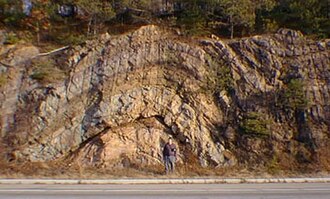Anticline

Definition: An anticline is a geological fold characterized by an arch-like structure where rock layers are bent upward into a convex shape.
Formation Process:
– Compression Begins: Tectonic forces exert pressure on the Earth’s crust due to the movement of tectonic plates, initiating a compressional stress.
– Fold Initiation: As the compressional stress increases, rocks start to deform and fold. Anticlines form when rocks are pushed up, creating an upward arch.
– Axial Plane Development: Then the imaginary plane along the crest of the fold, called the axial plane, develops as the folding progresses.
– Limbs and Axis Formation: The two sides of the fold, known as limbs, dip away from the axial plane. Note that the highest point on the fold is the anticline axis.
– Rocks at Core: Anticlines often have the oldest rocks at their core, as the folding process involves bending older rock layers.

Features:
– Axial Plane: The highest point along the crest of the fold.
– Limbs: The two sides of the fold that dip away from the axial plane.
– Anticline Axis: The highest point on the fold.
Examples: The Appalachian Mountains in North America showcase numerous anticlinal structures.
Syncline

Definition: A syncline is a geological fold characterized by a trough-like structure where rock layers are bent downward into a concave shape.
Formation Process:
– Compression Begins: Similar to anticlines, synclines form due to compressional stresses resulting from tectonic plate movements.
– Fold Initiation: As compression continues, rocks start to deform, and synclines develop when rocks are pushed downward, creating a trough-like structure.
– Axial Plane Development: In contrast to anticline folds, the imaginary plane along the lowest point of the fold, called the axial plane, develops as the folding progresses.
– Limbs and Axis Formation: The two sides of the fold, known as limbs, dip toward the axial plane. Thus making, the lowest point on the fold is the syncline axis.
– Rocks at Core: Synclines often have the youngest rocks at their core, as the folding process involves bending younger rock layers.

Features:
– Axial Plane: The lowest point along the trough of the fold.
– Limbs: The two sides of the fold that dip toward the axial plane.
– Syncline Axis: The lowest point on the fold.
Examples: The Green River Basin in Wyoming, USA, showcases well-developed synclines.
Significance
– Structural Geology: Anticlines and synclines provide valuable information about the geological history and tectonic forces that shaped an area.
– Natural Resources: These fold structures can influence the accumulation and trapping of natural resources like oil and gas. Anticlines, for instance, might serve as potential reservoirs.

